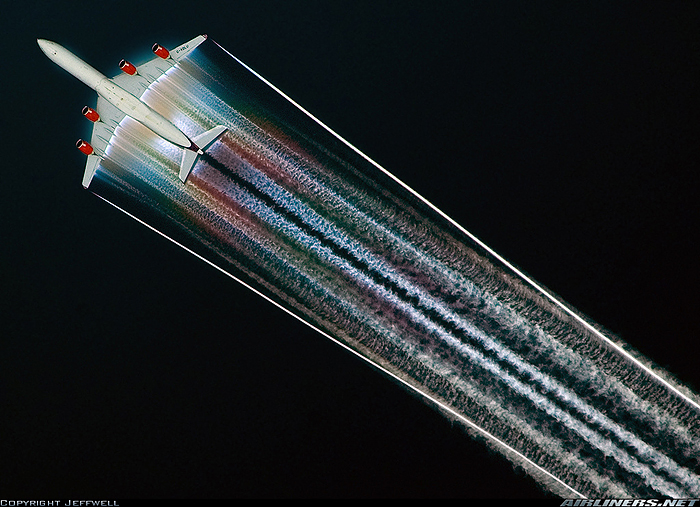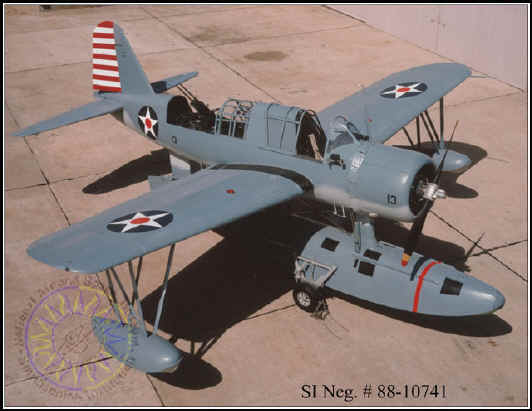| Topic: Three questions about flight | |
|---|---|
|
Edited by
elwoodsully
on
Tue 06/29/10 05:04 AM
|
|
|
I was watching an airplane go overhead a few minutes ago, and it brought to mind some questions.
1) At what height do contrails happen? I assumed they happen for most large jets at crusing altitudes, but saw none on a plane this morning. It seemed to be at about it's maximum altitude. 2) Say you're in a Harrier jet (hover capabilities), and it has a nuclear reactor instead of normal fuel. If you were to hover completely motionless for 24 hours, would the earth make one complete rotation under you? As in, would you actually fly (hover) over the entire planet? 3) If you were to fly straight over the equator from one airport to another. Say that they're 5,000 miles apart. Would the flight be shorter in one direction than the other? I'm taking into account the earth revolving at the same time. Pretty deep thoughts from a math kinda guy when out for a 6am smoke, right? |
|
|
|
|
|
I do not know about questions 2 and 3, but I think the first one doesn't have to do with altitude, but it has to do with the atmosphere and how much moisture or dirt paritcles are in the air for the vapors escaping the plane's engines, to attach to.
|
|
|
|
|
|
The answer to two is no, it wouldn't be revolving under you. To hover by definition is to stay over one place. If you let the earth spin under you, you're not hovering.
The answer to three is that the movie's gonna blow chow either way. |
|
|
|
|
|
Edited by
Kings_Knight
on
Tue 06/29/10 07:09 AM
|
|
|
Dunno about 2 and 3, but here's a shot at 1 ... and the movie would prolly still blow chunks ...
Figure between 35,000 and 37,000 feet ... RHmin = c + (.02c - .41)t _____________ (.003c - .14) where c = e(151 - alt) / 19. 5 and t = temperature of the atmosphere at flight altitude in degrees centigrade and alt = altitude of the jet aircraft in thousands of feet. |
|
|
|
|
|
Well, I found an answer for #1, but the plane I saw this morning was much higher than this:
Per Wikipedia- Exhaust vapour trails or contrails usually occur above 8000 meters (26,000 feet), where the temperature is below -40°C (-40°F). 9 years in the military, and 30+ years of living near Midway and O'Hare airports taught me a little bit about how high planes are flying. The plane this morning was roughly 35,000 ft. |
|
|
|
|
|
The answer to #3 is yes, one direction will be shorter than another. The main factor in play isn't the earth's rotation, but the Jet stream, thus East-to-West flights (against the jet stream) take longer than West-to-East (with the jet stream) flights.
|
|
|
|
|
|
Edited by
metalwing
on
Tue 06/29/10 12:55 PM
|
|
|
I was watching an airplane go overhead a few minutes ago, and it brought to mind some questions. 1) At what height do contrails happen? I assumed they happen for most large jets at crusing altitudes, but saw none on a plane this morning. It seemed to be at about it's maximum altitude. 2) Say you're in a Harrier jet (hover capabilities), and it has a nuclear reactor instead of normal fuel. If you were to hover completely motionless for 24 hours, would the earth make one complete rotation under you? As in, would you actually fly (hover) over the entire planet? 3) If you were to fly straight over the equator from one airport to another. Say that they're 5,000 miles apart. Would the flight be shorter in one direction than the other? I'm taking into account the earth revolving at the same time. Pretty deep thoughts from a math kinda guy when out for a 6am smoke, right? There are actually two kinds of contrails, fuel byproduct (jet exhaust) and water vapor from compression/decompression. The fuel burns to make a lot of water vapor which (if it is cold enough) will turn to mostly water droplets and then ice before it has time to disperse. These are the ones you mostly see around 25 to 40,000 feet. The vapor trails without fuel are causes by air compression of high speed jets usually supersonic. They produce much less vapor per unit area but quite a bit spread over the wing surfaces. The vapor trails usually evaporate but can freeze also. 
Motion is relative. You are spinning around the center of the earth. The earth is orbiting around the Sun. The Sun is orbiting around the center of the Milky Way. The Milky Way is orbiting in our galactic cluster. Our galactic cluster is rotating and moving in expanding space. All items provide a speed component in any given direction. Moving in any given direction on or above the surface of the earth can add or subtract from your actual speed and direction. You must decide if your speed is Global (all motion considered) or local (only local vectors considered). Local can be whatever motion you want relative to whatever point of reference you want. If your point of reference is only the earth, the longest flight is the one flying into the wind most of the time because the plane only feels the air it flys through. In this case "long" is time, not distance over the earth's surface. |
|
|
|
|
|
Edited by
AGoodGuy1026
on
Tue 06/29/10 01:29 PM
|
|
|
The answer to #3 is yes, one direction will be shorter than another. The main factor in play isn't the earth's rotation, but the Jet stream, thus East-to-West flights (against the jet stream) take longer than West-to-East (with the jet stream) flights. My view on #2. Some smarty physics guy should be able to apply Newtons laws and tell us the answer on this one? Sadly, calculus is not my thing :).. My view on #3. The distance will be the exact same both ways (not shorter) as measured on the ground. 5000 miles is 5000 miles either way... I agree with the above, headwind/tailwind will be the driving factor of the duration of the flight. $.02 
|
|
|
|
|
|
Well, I found an answer for #1, but the plane I saw this morning was much higher than this: Per Wikipedia- Exhaust vapour trails or contrails usually occur above 8000 meters (26,000 feet), where the temperature is below -40°C (-40°F). 9 years in the military, and 30+ years of living near Midway and O'Hare airports taught me a little bit about how high planes are flying. The plane this morning was roughly 35,000 ft. I don't understand why do you say "but the plane" rather than "and the plane", as 'but' can imply an inconsistency or contradiction. If wikipedia is correct, then it makes sense that you might see a contrail at 35k. Wikipedia is only saying that they occur above 26k, with no limitation being stated nor implied on how much higher a contrail might form. I'm probably reading too much into the word 'but'. |
|
|
|
|
|
The answer to #3 is yes, one direction will be shorter than another. The main factor in play isn't the earth's rotation, but the Jet stream, thus East-to-West flights (against the jet stream) take longer than West-to-East (with the jet stream) flights. Interesting, at first I assumed the OP was asking if the flight would 'shorter in actual distance traveled' rather than 'shorter in duration'. |
|
|
|
|
|
2) Say you're in a Harrier jet (hover capabilities), and it has a nuclear reactor instead of normal fuel. If you were to hover completely motionless for 24 hours, would the earth make one complete rotation under you? As in, would you actually fly (hover) over the entire planet? Metalwing is right. To say you are hovering 'motionless' is to leave unstated "motionless relative to what?". There is no such thing as 'absolutely' motionless - we have to simply choose a frame of reference. If you were 'motionless' with respect to the center of the earth, then yes the surface of the earth would pass under you...but you'd have to accelerate yourself continuously in one direction to overcome the influence of the earths atmosphere. On the other hand, you could simply be 'motionless' relative to the rotating frame of the earth itself - in which case you would hover at the same GPS coordinates. |
|
|
|
|
|
Contrails depend on not only on altitude but also on the air temp, the amount of water in the air, the planes air speed, and what type of engine and how much exhaust they are putting out,(that is what the throttles are set at). And yes piston planes will produce contrails.
If you fly around the equator, assuming the same air speed and altitude, and no wind, yes you will gain slightly in ground speed going one way versus the other. |
|
|
|
|
|
I was watching an airplane go overhead a few minutes ago, and it brought to mind some questions. 1) At what height do contrails happen? I assumed they happen for most large jets at crusing altitudes, but saw none on a plane this morning. It seemed to be at about it's maximum altitude. 2) Say you're in a Harrier jet (hover capabilities), and it has a nuclear reactor instead of normal fuel. If you were to hover completely motionless for 24 hours, would the earth make one complete rotation under you? As in, would you actually fly (hover) over the entire planet? 3) If you were to fly straight over the equator from one airport to another. Say that they're 5,000 miles apart. Would the flight be shorter in one direction than the other? I'm taking into account the earth revolving at the same time. Pretty deep thoughts from a math kinda guy when out for a 6am smoke, right? 1. The Stratosphere. Bombers during WWII had to fly above and below this point to not leave the tell tale trails behind giving them away to enemy ground fire. 2. No becasue of the atmosphere and wind. Technically a satellite in a stationary orbit does have the earth complete a rotation under it in 24 hours becasue nothing is up there to nudge the satellite along like wind. 3. Although the speed of the craft might be constant so is the direction of rotation and the trip would be longer or shorter according to direction of travel. Either you are rushing to a destination coming at you or you are chasing a destination moving away from you. The battleship New Jersey had a computer on board during WWII that actually took the rotation of the earth into account when assigning trajectories for targeting their main guns. |
|
|
|
|
|
Most capital ships, that is battle ships and cruisers, in WWII had RADAR targeting. That includes the Iowa class Battle ships; New Jersey, Iowa, and Wisconsin.
|
|
|
|
|
|
Most capital ships, that is battle ships and cruisers, in WWII had RADAR targeting. That includes the Iowa class Battle ships; New Jersey, Iowa, and Wisconsin. Radar assisted targeting was incorporated during the Korean War. The radar was more to watch for enemy bombers which were a threat to any ship. All Iowa class battle ships used a computer to aim the guns. Radar back in WWII did not have the capacity to discriminate land based targets, only air. Radar was really crude in WWII. Even aircraft fitted with Radar could only pursue other aircraft with it hence the Radar Guided Bomber Hunters like the P38J Lightning, P61 Black Widow, JU88, ME210, ME262, ME263, and several other radar equipped Bomber Killers. During WWII Radar was never used to site or target ground targets. It was marginally effective in locating ships becasue weather could interfere with older radar. All Iowa class warships in WWII had targeting computers. They were crude by today's standards yes but they worked. These days the New Jersey is equipped with radar and satellite (GPS) assisted targeting and modern targeting computers. With cannon you don't just aim and hope you have the right trajectory and angles. The targets ships like this would fire on were usually over the horizon anyways so Battleships were equipped with two Kingfisher Float Planes to help them sight and acquire targets. Radar cannot see over the horizon. 

That is how the New Jersey fired on targets past the horizon during WWII. |
|
|
|
|
|
Edited by
motowndowntown
on
Tue 07/06/10 05:36 PM
|
|
|
Most capital ships, that is battle ships and cruisers, in WWII had RADAR targeting. That includes the Iowa class Battle ships; New Jersey, Iowa, and Wisconsin. Radar assisted targeting was incorporated during the Korean War. The radar was more to watch for enemy bombers which were a threat to any ship. All Iowa class battle ships used a computer to aim the guns. Radar back in WWII did not have the capacity to discriminate land based targets, only air. Radar was really crude in WWII. Even aircraft fitted with Radar could only pursue other aircraft with it hence the Radar Guided Bomber Hunters like the P38J Lightning, P61 Black Widow, JU88, ME210, ME262, ME263, and several other radar equipped Bomber Killers. During WWII Radar was never used to site or target ground targets. It was marginally effective in locating ships becasue weather could interfere with older radar. All Iowa class warships in WWII had targeting computers. They were crude by today's standards yes but they worked. These days the New Jersey is equipped with radar and satellite (GPS) assisted targeting and modern targeting computers. With cannon you don't just aim and hope you have the right trajectory and angles. The targets ships like this would fire on were usually over the horizon anyways so Battleships were equipped with two Kingfisher Float Planes to help them sight and acquire targets. Radar cannot see over the horizon. That is how the New Jersey fired on targets past the horizon during WWII. RADAR gave direction and range to the target. The computers, which used gears and cogs and very little in the form of electronics computed, azimuth and elevation of the guns, charge, and took into account the roll and pitch of the ship. Yes targets that were over the horizon or on the ground needed a spotter, a plane, a man on the ground, or another ship, to call in corrections. The range of the sixteen inch guns on WWII battle ships was about 25 miles. |
|
|
|
|














